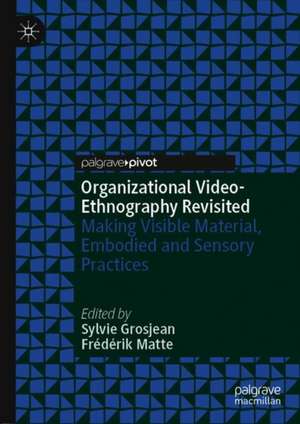Organizational Video-Ethnography Revisited: Making Visible Material, Embodied and Sensory Practices
Editat de Sylvie Grosjean, Frédérik Matteen Limba Engleză Hardback – 6 mar 2021
Preț: 453.21 lei
Nou
Puncte Express: 680
Preț estimativ în valută:
86.73€ • 94.18$ • 72.85£
86.73€ • 94.18$ • 72.85£
Carte tipărită la comandă
Livrare economică 22 aprilie-06 mai
Preluare comenzi: 021 569.72.76
Specificații
ISBN-13: 9783030655501
ISBN-10: 3030655504
Pagini: 176
Ilustrații: XVII, 176 p. 4 illus.
Dimensiuni: 148 x 210 mm
Greutate: 0.39 kg
Ediția:1st ed. 2021
Editura: Springer International Publishing
Colecția Palgrave Pivot
Locul publicării:Cham, Switzerland
ISBN-10: 3030655504
Pagini: 176
Ilustrații: XVII, 176 p. 4 illus.
Dimensiuni: 148 x 210 mm
Greutate: 0.39 kg
Ediția:1st ed. 2021
Editura: Springer International Publishing
Colecția Palgrave Pivot
Locul publicării:Cham, Switzerland
Cuprins
Chapter 1- Introduction. - Part 1- Video-Ethnography and Reflexivity-In-Practice: Making Visible the Embodied and Sensory Dimensions of Work Practices.- Chapter 2 - Video-ethnography and Video-reflexive Ethnography: Investigating and Expanding Learning about Complex Realities.- Chapter 3 - The Epistemic Use of the Body in Medical Radiology: Insights from Interactional Video-Ethnography.- Chapter 4 – The Two-sides of Video-ethnography for Studying “Sensing-at-distance".- Part 2: Video-Ethnography and Organizing Spaces: Sensing Places and the Multiple Nature of Working Spaces.- Chapter 5 - Practicing Diffraction in Video-based Research.- Chapter 6 - Using Video Methods to Uncover the Relational, Interactional and Practical Constitution of Space.- Chapter 7 - Participant Viewpoint Ethnography and Mobile Organizing.- Part 3: “Outsider” and “Insider” Video-Ethnographer: Exploring Multimodal and Multisensorial Workplace Settings.- Chapter 8 - Doing Video Ethnography Research with Top Management Teams.- Chapter 9 - Complementing Video-ethnography: The Uses and Potential of Mundane Data Collected on Social Media.
Recenzii
“The book valorizes the potentialities of video-ethnography making visible material, spatial, emotional, and sensory dimensions of workplace practices through the integration of participants’ perspectives. Its reading can surely enrich the approach of STS scholars interested in these sensorial dimensions and in the situatedness of knowledge produced in and through intra- and inter-actions between human actors, heterogenous artifacts, visual technologies, and scientific practices.” (Barbara Pentimalli, Tecnoscienza, Vol. 12 (2), 2021)
Notă biografică
Sylvie Grosjean is Professor at University of Ottawa (Canada). Her research focuses on design and use of telehealth innovations. She uses qualitative methods and develops Participatory Design approaches in health care settings. She has published in Symbolic Interaction, Management Communication Quaterly, Journal for Communication Studies, Sciences du Design, Innovations, Knowledge-Based Systems.
Frédérik Matte is Professor at University of Ottawa (Canada). He studies tensions in the extreme and emergency situations faced by international non-governmental organizations (INGOs). He has published in the International Journal of Communication, Journal of Communication, Communication Monographs, Discourse and Communication and Pragmatics & Society.
Frédérik Matte is Professor at University of Ottawa (Canada). He studies tensions in the extreme and emergency situations faced by international non-governmental organizations (INGOs). He has published in the International Journal of Communication, Journal of Communication, Communication Monographs, Discourse and Communication and Pragmatics & Society.
Textul de pe ultima copertă
This book explores the undeveloped potential of video-ethnography to study the material, embodied and sensory dimensions of workplace practices. With the growing interest in sociomateriality and the development of research on the embodied and sensory dimensions of organizational practices, some methodological challenges of this type of research need to be addressed. The main purpose of this book is to present various forms of video-ethnography that make organizational phenomena visible and help better appreciate the organizing properties of bodies, affects, senses and spaces in workplace practices. To do so, illustrative cases based on video-ethnography was discussed to understand how experiential and unspoken ways of knowing produced through a video-based approach can be made meaningful and relevant to study the material, embodied and sensory dimension of work practices. This book is addressed to researchers and students in social sciences and organizational studies and offers a methodological reflection on how to study the material, embodied, and sensory dimensions of organizational life.
Sylvie Grosjean is Professor at University of Ottawa (Canada). Her research focuses on design and use of telehealth innovations. She uses qualitative methods and develops Participatory Design approaches in health care settings. She has published in Symbolic Interaction, Management Communication Quaterly, Journal for Communication Studies, Sciences du Design, Innovations, Knowledge-Based Systems.
Frédérik Matte is Professor at University of Ottawa (Canada). He studies tensions in the extreme and emergency situations faced by international non-governmental organizations (INGOs). He has published in the International Journal of Communication, Journal of Communication, Communication Monographs, Discourse and Communication and Pragmatics & Society.
Frédérik Matte is Professor at University of Ottawa (Canada). He studies tensions in the extreme and emergency situations faced by international non-governmental organizations (INGOs). He has published in the International Journal of Communication, Journal of Communication, Communication Monographs, Discourse and Communication and Pragmatics & Society.
Caracteristici
Intends to explore the undeveloped potential of video-ethnography to study the material, embodied, and sensory dimensions of workplace practices Presents various forms of video-ethnography that make organizational phenomena visible and help better appreciate the organizing properties of bodies, affects, senses, and spaces in workplace practices Offers a methodological reflection on how to study the material, embodied, and sensory dimensions of organizational life
